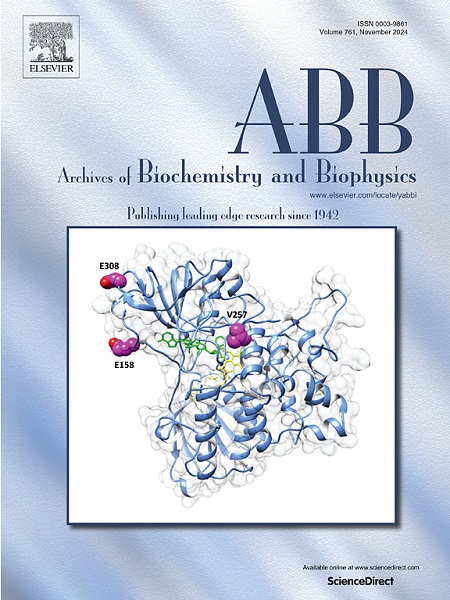Characterizations of angiotensin-converting enzyme-2 (ACE2) peptidase activity
IF 3.8
3区 生物学
Q2 BIOCHEMISTRY & MOLECULAR BIOLOGY
引用次数: 0
Abstract
Angiotensin (Ang) II (1–8) is a potent vasoconstrictor known for its role in hypertension. Angiotensin-converting enzyme (ACE2) converts Ang II (1–8) to a vasodilator Ang (1–7) by removing the carboxy-terminal Phe. ACE2 more recently gained attention as the receptor for severe acute respiratory syndrome coronavirus 2 (SARS-CoV-2) that caused the coronavirus disease 2019 (COVID-19) pandemic. Given the pathophysiological importance of ACE2, the present study examined the mechanism of ACE2 catalytic activity by comparing the ability of angiotensin molecules of various lengths to compete with the artificial fluorogenic substrate. The Fluorimetric SensoLyte 390 ACE2 Activity Assay uses an Mca/Dnp fluorescence resonance energy transfer peptide as the substrate. Results showed that the natural substrate Ang II (1–8) competed with the fluorogenic substrate, reducing the fluorescence signals. Deletion of C-terminal Phe resulted in the loss of the ability to compete with the artificial substrate, as shown by the actions of Ang (1–7), Ang (2–7), and Ang (5–7). By contrast, the loss of N-terminal Asp potentiated the ability to compete with the substrate as seen by the action of Ang III (2–8). However, the loss of two amino acids (Asp-Arg) from the N-terminus reduced the ability to compete with the substrate as observed by the actions of Ang IV (3–8) and Ang (5–8). Ang I (1–10) and Ang (1–9) did not strongly compete with the substrate. Interestingly, shorter peptides Ang (1–5) and Ang (1–4) potentiated the ACE2 activity. These results suggest that Ang II and Ang III are the best natural substrates for ACE2.

血管紧张素转换酶-2(ACE2)肽酶活性的特征。
血管紧张素(Ang)II(1-8)是一种强效的血管收缩剂,因其在高血压中的作用而闻名。血管紧张素转换酶(ACE2)通过去除羧基末端的 Phe,将 Ang II(1-8)转换为血管扩张剂 Ang(1-7)。最近,ACE2 作为导致 2019 年冠状病毒病(COVID-19)大流行的严重急性呼吸系统综合征冠状病毒 2(SARS-CoV-2)的受体而受到关注。鉴于 ACE2 在病理生理学方面的重要性,本研究通过比较不同长度的血管紧张素分子与人工荧光底物竞争的能力,研究了 ACE2 催化活性的机制。荧光测定 SensoLyte 390 ACE2 活性测定法使用 Mca/Dnp 荧光共振能量转移肽作为底物。结果显示,天然底物 Ang II(1-8)与荧光底物竞争,减少了荧光信号。从 Ang (1-7)、Ang (2-7) 和 Ang (5-7) 的作用中可以看出,删除 C 端 Phe 会导致失去与人工底物竞争的能力。相比之下,N 端 Asp 的缺失增强了与底物竞争的能力,如 Ang III 的作用(2-8)所示。然而,从 Ang IV(3-8)和 Ang(5-8)的作用中可以看出,从 N 端损失两个氨基酸(Asp-Arg)会降低与底物竞争的能力。Ang I(1-10)和 Ang(1-9)与底物的竞争性不强。有趣的是,短肽 Ang (1-5) 和 Ang (1-4) 能增强 ACE2 的活性。这些结果表明,Ang II 和 Ang III 是 ACE2 的最佳天然底物。
本文章由计算机程序翻译,如有差异,请以英文原文为准。
求助全文
约1分钟内获得全文
求助全文
来源期刊

Archives of biochemistry and biophysics
生物-生化与分子生物学
CiteScore
7.40
自引率
0.00%
发文量
245
审稿时长
26 days
期刊介绍:
Archives of Biochemistry and Biophysics publishes quality original articles and reviews in the developing areas of biochemistry and biophysics.
Research Areas Include:
• Enzyme and protein structure, function, regulation. Folding, turnover, and post-translational processing
• Biological oxidations, free radical reactions, redox signaling, oxygenases, P450 reactions
• Signal transduction, receptors, membrane transport, intracellular signals. Cellular and integrated metabolism.
 求助内容:
求助内容: 应助结果提醒方式:
应助结果提醒方式:


